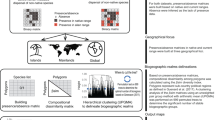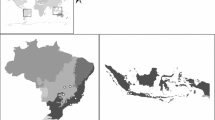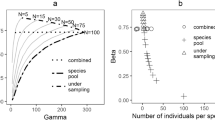Abstract
Geographical diversity gradients, even among local communities, can ultimately arise from geographical differences in speciation and extinction rates. We evaluated three models—energy-speciation, energy-abundance, and area—that predict how geographic trends in net diversification rates generate trends in diversity. We sampled 96 litter ant communities from four provinces: Australia, Madagascar, North America, and South America. The energy-speciation hypothesis best predicted ant species richness by accurately predicting the slope of the temperature diversity curve, and accounting for most of the variation in diversity. The communities showed a strong latitudinal gradient in species richness as well as inter-province differences in diversity. The former vanished in the temperature-diversity residuals, suggesting that the latitudinal gradient arises primarily from higher diversification rates in the tropics. However, inter-province differences in diversity persisted in those residuals—South American communities remained more diverse than those in North America and Australia even after the effects of temperature were removed.



Similar content being viewed by others
References
Allen AP, Brown JH, Gillooly JF (2002) Global biodiversity, biochemical kinetics, and the energetic-equivalence rule. Science 297:1545–1548
ArcView (1999) ArcGIS. 8.1. Environmental Systems and Research Institute, Redlands
Barraclough TG, Savolainen V (2001) Evolutionary rates and species diversity in flowering plants. Evolution 65:677–683
Beattie AJ (1985) The evolutionary ecology of ant-plant mutualisms. Cambridge University Press, Cambridge
Besuchet C, Burckhardt D, Lobl I (1987) The “Winkler/Mocsarski” eclector as an efficient extractor for fungus and litter coleoptera. Coleopt Bull 41:392–394
Bromham L, Cardillo M (2003) Testing the link between the latitudinal gradient in species richness and rates of molecular evolution. J Evol Biol 16:200–207
Brown JH, Lomolino MV (1998) Biogeography, 2 edn. Sinauer, Sunderland, Mass.
Buzas MA, Collins LS, CulverSJ (2002) Latitudinal difference in biodiversity caused by higher tropical rate of increase. In: Proc Natl Acad Sci USA 99:7841–7843
Cardillo M (1999) Latitude and rates of diversification in birds and butterflies. Proc R Soc Lond B 266:1221–1225
Chase JM, Liebold MA (2002) Spatial scale dictates the productivity-biodiversity relationship. Nature 416:427–430
Chazdon RL, Colwell RK, Denslow JS, Guariguata MR (1998) Statistical methods for estimating species richness of woody regeneration in primary and secondary rain forests of NE Costa Rica. In: Dallmeier F, Comiskey JA (eds) Forest biodiversity research, monitoring and modeling: conceptual background and Old World case studies. Parthenon, Paris, pp 285–309
Chown S, Gaston K (2000) Areas, cradles and museums: the latitudinal gradient in species richness. Trend Ecol Evol 15:311–315
Clements F (1936) Nature and structure of the climax. J Ecol 24:252–284
Colwell R (1997) Estimate S: statistical estimation of species richness and shared species from samples. Version 5. User’s guide and application http://viceroy.eeb.uconn.edu/estimates.
Colwell R, Coddington J (1994) Estimating terrestrial biodiversity through extrapolation. Phil Trans R Soc Lond B 345:101–118
Colwell RK, Lees DC (2000) The mid-domain effect: geometric constraints on the geography of species richness. Trends Ecol Evol 15:70–76
Currie DJ (1991) Energy and large-scale patterns of animal- and plant-species richness. Am Nat 137:27–49
Cushman JH, Whitham TG (1991) Competition mediating the outcome of a mutualism: protective services of ants as a limiting resource for membracids. Am Nat 138:851–865
Cushman JH, Lawton JH, Manly BFJ (1993) Latitudinal patterns in European ant assemblages variation in species richness and body size. Oecologia 95:30–37
Damuth J (1981) Interspecific allometry of population density in mammals and other animals: the independence of body mass and population energy use. Biol J Linn Soc 31:193–246
Davis MB (1976) Pleistocene biogeography of temperate deciduous forests. Geosci Man 13:13–26
Draper NR, Smith H (1981) Applied regression analysis. Wiley, New York
Elton C (1927) Animal ecology. MacMillan, New York
Elton C (1958) The ecology of invasions by animals and plants. Methuen, London
Field CB, Randerson JT, Malmström CM (1995) Global net primary production: combining ecology and remote sensing. Remote Sensing Environ 51:74–97
Franks NR (1982) Social insects in the aftermath of swarm raids of the army ant Eciton burchelli. In: Breed MD, Michener CD, Evans HE (eds) The biology of social insects. Proceedings of the 9th Congress of the International Union for the Study of Social Insects, Boulder, Colorado, August 1982. Westview, Boulder, Colo., pp 275–279
Gaston KJ (2000) Global patterns in biodiversity. Nature 405:220–227
Gillooly JF, Charnov EL, West GB, Savage VM, Brown JH (2002) Effect of size and temperature on developmental time. Nature 417:70–73
Gleason H (1926) The individualistic concept of the plant association. Bull Torrey Bot Club 53:7–26
Gotelli NJ, Arnett AE (2000) Biogeographic effects of red fire ant invasion. Ecol Lett 3:257–261
Holldobler B, Wilson EO (1990) The ants. Belknap, Cambridge
Holway DA (1998) Effect of Argentine ant invasions on ground-dwelling arthropods in northern California riparian woodlands. Oecologia 116:252–258
Hubbell S (2001) The unified neutral theory of biodiversity and biogeography. Princeton University Press, Princeton, N.J.
Hubbell SP, Foster RB (1986) Biology, chance, and history and the structure or tropical rain forest tree communities. In: Diamond J, Case T (eds) Community ecology. Harper and Row, New York, pp 314–329
Human K, Gordon D (1997) Effects of Argentine ants on invertebrate biodiversity in northern California. Conserv Biol 11:1242–1248
IPPC (1988) Observed climate datasets, vol 2002. Intergovernmental Panel on Climate Change, World Meterological Association
Jeanne RL (1979) A latitudinal gradient in rates of ant predation. Ecology 60:1211–1224
Kaspari M (2000a) Arboreal pitfall traps show impact of imported fire ants (Solenopsis wagneri) on a Texas arboreal ant assemblage. Southwest Nat 45:118–122
Kaspari M (2000b) A primer of ant ecology. In: Agosti D, Alonso L (eds) Measuring and monitoring biological diversity: standard methods for ground-living ants. Smithsonian Press, Washington, D.C.
Kaspari M, O’Donnell S (2003) High rates of army ant raids in the Neotropics and implications for ant colony and community structure. Evol Ecol Res 5:933–939
Kaspari M, Vargo E (1995) Colony size as a buffer against seasonality: Bergmann’s rule in social insects. Am Nat 145:610–632
Kaspari M, Alonso L, O’Donnell S (2000a) Three energy variables predict ant abundance at a geographic scale. Proc R Soc Lond B 267:485–490
Kaspari M, O’Donnell S, Kercher J (2000b) Energy, density, and constraints to species richness: ant assemblages along a productivity gradient. Am Nat 155:280–293
Kaspari M, Pickering J, Longino J, Windsor D (2001) The phenology of a Neotropical ant assemblage: evidence for continuous and overlapping reproduction. Behav Ecol Sociobiol 50:382–390
Kaspari M, Yuan M, Alonso L (2003) Spatial grain and the causes of regional diversity gradients in ants. Am Nat 161:459–477
Lees DC, Kremen C, Andriamampianina L (1999) A null model for species richness gradients: bounded range overlap of butterflies and other rainforest endemics of Madagascar. Biol J Linn Soc 67:529–584
Leigh EGJ (1981) The average lifetime of a population in a varying environment. J Theor Biol 90:212–239
Levey D, Byrne M (1993) Complex ant-plant interactions: rainforest ants as secondary dispersers and post-dispersal seed predators of rain forest plants. Ecology 74:1802–1812
Levinton J (1979) A theory of diversity equilibrium and morphological evolution. Science 204:335–336
Longino JT, Colwell RK (1997) Biodiversity assessment using structured inventory: capturing the ant fauna of a tropical rain forest. Ecol Appl 7:1263–1277
McPeek MA, Brown JM (2000) Building a regional species pool: diversification of the Enallagma damselflies in eastern North America. Ecology 81:904–920
Merriam C (1898) Life zones and crop zones of the United States. US Department of Agriculture, Washington, D.C.
Orians G, Pearson R (1983) Convergent evolution at the community level. In: Futuyma D, Slatkin M (eds) Coevolution. Sinauer, Sunderland, Mass. pp 431–458
Otte D, Endler JA (1989) Speciation and its consequences. Sinauer, Sunderland. Mass.
Pianka E (1966) Latitudinal gradients in species diversity: a review of the concepts. Am Nat 100:33–46
Pianka ER (1986) Ecology and natural history of desert lizards. Princeton University Press, Princeton, N.J.
Pimm SL, Jones HL, Diamond J (1988) On the risk of extinction. Am Nat 132:757–785
Porter SD (1988) Impact of temperature on colony growth and developmental rates of the ant, Solenopsis invicta. J Insect Physiol 34:1127–1133
Rahbek C, Graves GR (2002) Multiscale assessment of patterns of avian species richness. Proc Natl Acad Sci USA 98:4534–4539
Richards J (1993) Remote sensing digital image analysis: an introduction. Springer, Berlin Heidelberg New York
Ricklefs RE (1987) Community diversity: relative roles of local and regional processes. Science 235:167–171
Ricklefs RE, Schluter D (1993) Species diversity in ecological communities: historical and geographical perspectives. University of Chicago Press, Chicago, Ill.,
Rohde K (1992) Latitudinal gradients in species diversity: the search for the primary cause. Oikos 65:514–527
Rosenzweig M (1968) Net primary productivity of terrestrial environments: predictions from climatological data. Am Nat 102:67–74
Rosenzweig ML (1995) Species diversity in space and time. Cambridge University Press, Cambridge
Roy K, Jablonski D, Valentine J, Rosenberg G (1998) Marine latitudinal diversity gradients: tests of causal hypotheses. Proc Natl Acad Sci 95:3699–3702
Russo SE, Robinson SK, Terborgh JT (2003) Size-abundance relationships in an amazonian bird community: implications for the energetic equivalence rule. Am Nat 161:267–283
Schluter D (1986) Tests for similarity and convergence of finch communities. Ecology 67:1073–1085
Sokal RR, Rohlf FJ (1981) Biometry. Freeman, New York
Srivastava DS, Lawton JH (1998) Why more productive sites have more species: an experimental test of theory using tree-hole communities. Am Nat 152:510–529
Terborgh J (1973) On the notion of favorableness in plant ecology. Am Nat 107:481–501
Tilman D (1978) Cherries, ants and tent caterpillars: timing of nectar production in relation to susceptibility of caterpillars to ant predation. Ecology 59:686–692
Tilman D, Pacala S (1993) The maintenance of species richness in plant communities. In: Ricklefs RE, Schluter D (eds) Species diversity in ecological communities: historical and geographical perspectives. University of Chicago Press, Chicago, Ill., pp 13–25
Ward PS (1987) Distribution of the introduced Argentine ant (Iridomyrmex humilis) in natural habitats of the Lower Sacramento Valley and its effects on the indigenous ant fauna. Hilgardia 55(2):1–16
Ward PS (2000) Broad-scale patterns of diversity in leaf litter ant communities. In: Agost D, Majer JD, Alonso LE, Schultz TR (eds) Ants: standard methods for measuring and monitoring biodiversity. Smithsonian Institution, Washington, D.C., pp 99–121
Wright DH, Currie DJ, Maurer BA (1993) Energy supply and patterns of species richness on local and regional scales. In: Ricklefs RE, Schluter D (eds) Species diversity in ecological communities: historical and geographical perspectives. University of Chicago Press, Chicago, Ill., pp 66–74
Acknowledgements
We thank Donat Agosti for providing the impetus to get this data analyzed. Field collection of data by P. S. W. was subsidized by NSF and the University of California at Davis. Data analysis by M. E. K. was supported by the National Science Foundation DEB-0212386. GIS analysis by M. Y. was in part supported by the National Science Foundation SES-0074620. Thanks to Nick Gotelli, Ian Billick, Dan Simberloff and Craig Osenberg for many useful comments on the manuscript.
Author information
Authors and Affiliations
Corresponding author
Rights and permissions
About this article
Cite this article
Kaspari, M., Ward, P.S. & Yuan, M. Energy gradients and the geographic distribution of local ant diversity. Oecologia 140, 407–413 (2004). https://doi.org/10.1007/s00442-004-1607-2
Received:
Accepted:
Published:
Issue Date:
DOI: https://doi.org/10.1007/s00442-004-1607-2




